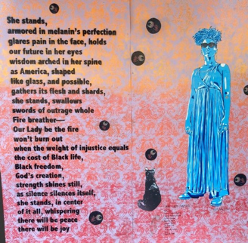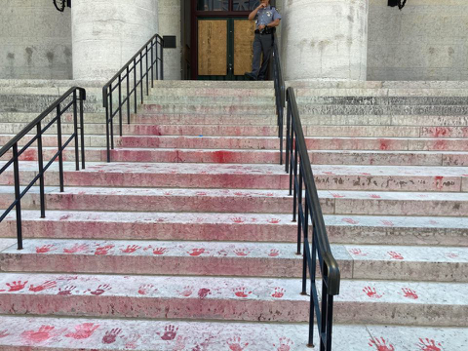As a sociologist, my area of specialty is the study of social movements. Specifically, I am interested in how social movements represent themselves visually. In other words, protest art is something I can really geek out on.
However, being neither an artist nor someone who has been able to attend protests due to health concerns, I knew I would miss part of the story if I wrote this one on my own. To get more perspective, I decided to talk to a better-informed friend.
Claressa Dalloway is an artist who has been actively involved in many of the protests in downtown Cbus. As such, she is familiar with events as they took place in the height of the protest in May and early June. We decided that the best way to interact with the art was to pick a point near the Statehouse, and just start walking.
FIRST ART PIECE: FACE CRYING - ABOVE
JB: “So, here is one. What do you think about this one?”
CD: “A lot of the windows are boarded up, so a lot of the art that is similar to this.
“When the protests started, this kind of spray paint graffiti style popped up first. Then these art groups came in, like the greater Columbus Arts Counsel, and started paying artists to sort of paint over the original art.
“So they started to pay for these artists to come in, and a lot of the artists were white. They were painting over these naturally made murals. The ones that are on High Street, across from the State house, someone had made a list of people who had died from police violence. So when that was being painted over, it really did anger a lot of people. They were painting over the names of the reason why people were there with these white washed murals! The murals that are there now are pretty, but it was not really the movement.”
SECOND ART PIECE: THREE GEORGE FLOYD FACES - BELOW
JB: “Why do you like this one?”
CD: “I think it kind of resembles street art in the most natural way. This is kind of classic protest art. It is a mural, it’s not overthought. It’s George Floyd’s face. Black Lives Matter.
JB: “You think that’s a stencil? It looks like a stencil…”
(JB Note: this mural is at least 8 feet tall, I have never seen a stencil that big. However, most of my experience with stencils is making punk t-shirts.)
CD: “Yea, it is a stencil. You should see a version of this stencil in different sizes from here through out the Short North. And it was nice, because this was kind of naturally popping up. On buildings, not just on the plywood (where permission was given.)”
JB: “Have you seen the stencil?”
CD: “I haven’t seen it. I haven’t seen it being put up, but at one point it was on the Ohio Supreme Court. You see it more on the sides of buildings. Places where it is not designated for.”
THIRD ART PIECE: WITH A QUOTE - BELOW
We then stopped to look at some of the art put up on the plywood in front of the Palace Theater
CD: “This is obviously more professional. It just has a nice quote, and is visually pleasing .”
JB: “It basically speaks for itself.”
CD: “Yea.”
JB: “Ok.”
FOURTH ART PIECE: RED HANDPRINT ART - BELOW
CD: “The red hand print art. That was the participatory art that a lot of people took part in.”
JB: “Were there a lot of people who did that?”
CD: “I’m gonna guess! Did you see it? There were thousands of hand prints! I can’t imagine that one person did it!”
JB: “You’re right, you know, I just didn’t put that together. You would have needed a crew of at least 20 to make that happen.”
CD: “It caught the spirit of what happened in the moment. It didn’t ask permission.”
We then walked over to the statehouse so that I could see the hand prints for myself
CD: “Well, it’s still here. I guess paint is really hard to get off” “I like how in trying to wash it off, it gives it that dripping look. You can see the handprints here.”
JB: “Yea there are littler prints and bigger ones. And some are almost different styles of printing. (Pointing) These are clearly two different people. And different colors of red, so there would have had to be multiple paint buckets”
CD: Right, this is a participatory art project. “
This relatively short column simply cannot capture the full scope of the art that is currently present around the Ohio Statehouse (in both sanctioned and unsanctioned spaces). While each piece tells its own story, when they exist in the same space at the same time, they tell a larger story. It is a story of oppression of black people by a society that is built on the foundation of oppression and genocide. It is also a story of class and privilege, of commissioned art that is respected and People’s Art that is pressure-washed away because an artist didn’t ask the Elite for permission. People are sick of asking for permission.
Jeremy is a college lecturer and is on the Board of the Columbus Institute for Contemporary Journalism. He teaches at The Ohio State University, Otterbein University, and The Cleveland School of Cannabis (but his views are his and his alone.) In Summer 2020, he will be teaching a course on Environmental Justice at OSU Marion that will focus on applying solarpunk thinking to societal issues created by Climate Change. More information about his projects can be found at www.sociology.pizza



